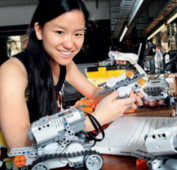Laura Diment
Combining computer science with medicine and healthcare could solve some of society’s biggest problems, and at the centre of it all is coding. “It’s used in everything from app development to reading large volumes of data,” says Flinders University biomedical engineering student, Laura Diment.
What did she do?
For her degree, Laura wrote a program called Splashboard that uses Microsoft Kinect to help kids with cerebral palsy, who have limited motor control, create their own artworks. Her interest in health tech began while working as a volunteer teacher in Uganda, where she found there was an urgent need for medical devices. She’s since won a scholarship to do her PhD at Oxford University in the UK, where she’ll research biomechanical modelling to design walking aids for people in developing countries. The healthcare and social assistance industry employs more Australians than any other field.
Other careers in the C.S. area
One in five new jobs over the next five years will emerge in this area.Many of the new jobs will be in startups like 2Mar Robotics, founded by biomedical engineer Marita Cheng, Young Australian of the Year 2012. Their inventions include the Jeva robotic arm, which people with limited mobility can control by tablet or phone. 2Mar’s low-cost ‘telepresence’ robot, Teleroo, is a video telephone on wheels that can be controlled remotely by disability carers. Starting a company was “always a dream” for Marita. “When I read about three young guys in the USA starting their own robotics company, I realised, if they can do it, I can!” Marita is one of a fast-growing number of people creating health tech startups. In the USA by 2017, it’s estimated $6.5billion a year will be invested in digital health startups. A Startup Weekend for Health has been set up in Australia to offer teams a forum to showcase their ideas. Robotics is just one small part of health technology – a vast and expanding field that includes remote patient care, wearable devices that record brainwaves and blood pressure, and ways to crowdsource data to rapidly understand trends in disease and injury. Gareth Goodier, chief executive at Melbourne Health, says hospitals are becoming increasingly dependent on technology. “The electronic hospital has digital patient records accessed by Wi-Fi on iPads. There’s voice recognition, radio frequency ID chips in equipment, staff ID tags and patient wristbands to track people and measure efficiency,” he says. The health system of tomorrow will be an exciting place to work. “The future is in the coding and technology side of healthcare,” says Laura.
C.S. Education


